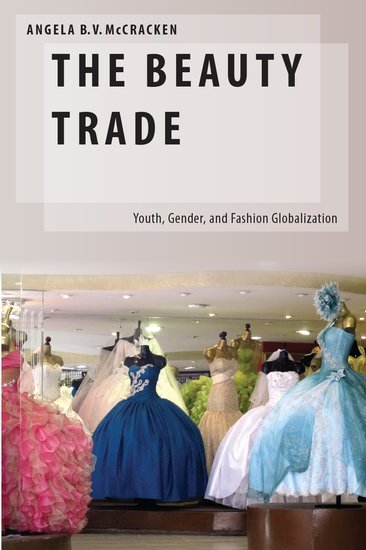
Through the lens of beauty products, practices, and ideas of youth in Guadalajara, Mexico, The Beauty Trade aims to analyze whether and how beauty norms are changing in relation to the globalizing beauty economy. Angela McCracken asks who benefits and who loses from beauty globalization and what this means for gender norms among young people. Sneha Krishnan finds that this book is extremely comprehensive and engages with some of the most exciting debates ongoing in the fields of gender, development, and cultural studies. Both as a resource for researchers, and for undergraduate and graduate students seeking to understand the importance of consumption to the larger political economies of globalisation, this book is commendable.
 The Beauty Trade: Youth, Gender and Fashion Globalization. Angela B.V. McCracken. Oxford University Press. 2014.
The Beauty Trade: Youth, Gender and Fashion Globalization. Angela B.V. McCracken. Oxford University Press. 2014.
Angela McCracken’s book is a thoroughly researched view into consumption, youth, and beauty in Mexico. It arrives at a time when researchers of youth and globalisation all over the world are asking questions about young people’s agency, about the homogenisation of standards of beauty and youth, and about how the consumption of fashion shapes young women’s subjectivities in different socio-political contexts. McCracken’s book takes a nuanced and multidimensional view on all these topics as it seeks to focus on a somewhat less explored aspect of beauty in Latin America: its political economy.
McCracken – a Lecturer in International Relations en University of Southern California – begins by making a powerful argument as to why the study of fashion’s political economy is relevant to a wider understanding of race, gender, and national power in the world today. Fashion, she suggests, demonstrates how the rapidly transforming politics of nationhood in the last two decades, as well as structural transformation of economic institutions in countries like Mexico, interacts with the intimate sphere of people’s lives in which beautification and fashion are actually practiced. Beauty, she argues, here agreeing with emerging feminist scholarship in this field, is closely tied to a number of intersecting axes of privilege, and is thus revealing of how other identities come to be configured. Placing its study of the beauty industry in this context, this book takes the view that globalisation has, far from creating homogenised experiences of youth and fashion, instead elicited creative appropriations of its discourses. Local traditions have changed and grown diversified in these years, but not been absorbed into any overarching narratives about young womanhood emanating from the Anglo-Saxon West.
Organised into six substantive chapters, rich in ethnographic description, and bookended by a comprehensive introduction and conclusion, this book gradually develops its arguments about how the local and the global are mutually constitutive of each other, through a study of the everyday political economy of beauty. Starting with a coming of age ritual, the first chapter examines notions of adulthood and youth as an entry point into introducing the reader to the book’s chief themes. The next two chapters examine practices of beautification and fashion connected with the quince años and Quinceañera (a girl’s fifteenth birthday celebration) in Mexican culture as symbolising ideas of traditional beauty and Mexican femininity in a time of globalisation, beauty pageants, and the increasing marketization of young women’s bodies. Focussing here on the makeover that is central to the young woman’s debut as someone who has stepped out of childhood, McCracken examines how young women appropriate and shape global discourses of beauty and womanhood.
The next two chapters examine the commercialisation of beauty and fashion in Mexico; practices that, as McCracken convincingly shows, also reconfigure family relationships as young people seek to create unique Quinceañera celebrations for themselves, breaking from some traditional practices, while reproducing others. Chapter six looks at subcultures in the beauty economy – young women who undo the power of the Quinceañera and its traditional representation of Mexican beauty through counter-cultural forms of beauty. These forms of resistance, McCracken shows, speak the language of globalisation just as much as more traditional forms of beauty do. Indeed, as she demonstrates, they often engage in the reproduction of traditional notions of femininity and beauty, just as much as Quinceañeras and other instances of what we identify as ‘traditional’ beautification practices.

This sixth chapter is particularly interesting also because it brings into relief some of the arguments made in previous chapters about how standards of beauty circulate and create ideals of gender and race. Focussing on what McCracken calls a virtual economy of finance, information, and cultural signs, she demonstrates how young women subvert and appropriate some of these ideals to create subcultural ideals of beauty that depart from what we might identify as traditional or conservative notions of femininity. Focussing here on brands and their use by young people, McCracken examines young women’s agency as actors who seek to appear increasingly unique, even as they want to fit in with others. This argument speaks in many ways to literatures from Asian countries about the increasing importance of individual selves as unique: self-realisations which emphasise the significance of standing out, it has been suggested, are central to the subjectivities constructed in response to globalisation.
This chapter also examines the brand, as a cultural sign, around which shifting communities of interpretation form. McCracken looks at how young women invoke American popstars and actresses – Shakira, Fergie, Britney Spears and Hillary Duff for instance – as representative of body types and forms of beauty they sought to imitate. Examining this, the author makes a compelling argument that while it is tempting to cast this as a hegemonic homogenising force, an aspect of the Americanisation of the rest of the world, youth obsession with the images of Western actresses and the cultural values they see in Western brand names often equally inspires fashion entrepreneurialism among young women. Young women thus move between being consumers in the fashion industry to being equally agenda-setters and producers of original fashion.
Themes I might have liked to see explored in greater detail in McCracken’s book relate to the political economy of the counterfeit. ‘Pirate modernities’ or ‘counterfeit modernities’ centering on the production and circulation of products that are imitations of goods produced and sold in the West are increasingly studied in the context of developing nations. As a number of scholars have argued, these political economies of the ‘fake’ demonstrate the ways in which Western modernity is creatively reproduced, and moulded to the contexts of the localities into which it is taken. It might have been interesting to read about the ways in which the political economy of beauty engages in practices of ‘fakery’ or ‘counterfeit’ and what we might learn about Mexican modernities from this.
That apart, this book is extremely comprehensive and engages with some of the most exciting debates ongoing in the fields of gender, development, and cultural studies. Both as a resource for researchers, and for undergraduate and graduate students seeking to understand the importance of consumption to the larger political economies of globalisation, this book is commendable.
Note: This review gives the views of the author, and not the position of the LSE Review of Books blog, or of the London School of Economics.
Image Credit: Girl ready for Quinceañera celebrations. Joshua Bousel CC BY-NC-SA 2.0.







